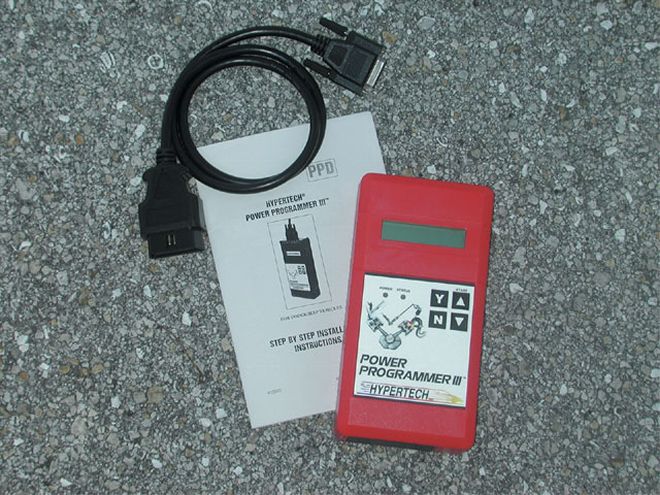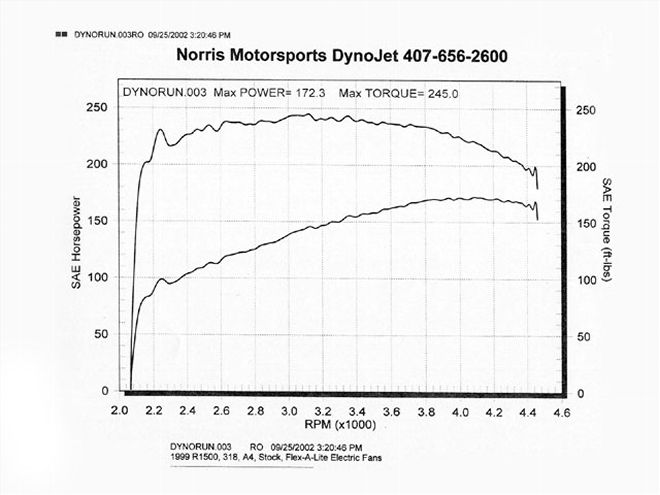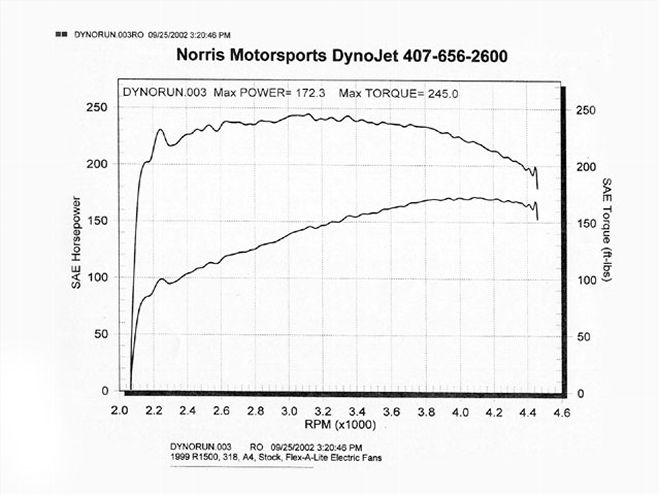
 Finally, Hypertech has released a Power Programmer III for Dodge truck applications. It's the easiest horsepower and torque grab you'll ever make.
Finally, Hypertech has released a Power Programmer III for Dodge truck applications. It's the easiest horsepower and torque grab you'll ever make.
When we first heard of Hypertech's Power Programmer III (PPIII) a few years ago, we thought, "cool idea!" The ability to customize the programming of a vehicle's stock computer without having to change the ECU or use multiple aftermarket chips to meet varying performance requirements held great appeal. Unfortunately, the PPIII was only available for GM applications at that time. When Hypertech released a version for Ford applications, we started to feel a bit . . . well . . . put out. On the plus side, Hypertech heard our groanings, and just last year the company finally created a PPIII designed for Dodge vehicles.
As most of you are probably aware (and as we discussed in our February issue), there are a host of aftermarket performance chips available for Dodge trucks. The idea behind these chips is to remap engine timing events and fuel ratios based on various conditions, such as load, fuel octane, operating temperatures, emissions, and so on, in order to negate the stock computer's built-in performance limitations. ECU programming via replacement or "piggy-back" chips can boost horsepower and torque in a stock vehicle, and is highly recommended for modified engines in order to take full advantage of upgrades made to the cooling, intake, and exhaust systems.
One disadvantage of the "replacement chip" is that most have only one program. You purchase the chip for your specific application, and there are no additional adjustments available. If you want to change your octane rating or rev limiter, you must buy another chip. The Hypertech PPIII, on the other hand, allows the user to adjust a handful of operating parameters on an as-needed basis (87 or 93 octane, rev limiter, top speed) and revert back to the stock programming in case he or she needs to take the vehicle to the dealer for diagnostic work.
Another benefit of the PPIII is that it's simple to operate. Installation is no more challenging than plugging the unit into the diagnostic port located at the bottom of the dashpanel. Programming your truck's computer involves answering a series of "yes" or "no" questions that you input via the PPIII's control box. That's all there is to it.
You order a PPIII based on your truck's model, year, engine, and transmission, as well as the number on your ECU (a label found on the module). Programming begins with the PPIII recognizing and downloading your stock computer programming into the control box. Once done, the PPIII will take you through a series of questions regarding your preferred octane level, top rpm limit, and top speed (tire rating). You can leave some stock settings and change others depending on the performance you want to achieve. Once you've made your selections, the PPIII will overwrite the stock computer with the new programming parameters you've chosen. Now your truck has optimal ignition timing and air:fuel ratio to squeeze out that extra horsepower and torque. When you wish to change the programming or revert back to the stock settings, it's a simple matter of plugging in the PPIII and going through the process again.
The PPIII is available for '97-'01 Dodge trucks (Ram, Dakota, Durango) with 5.2- or 5.9-liter engines.
 Rather than divine the actual benefits of the PPIII by the seat of our pants, we wanted to see what the reprogramming would show on a chassis dyno. Former Mopar Muscle staffer Tom Rounds uploaded the PPIII programming into his '99 Ram (5.2L, auto tranny), which is bone-stock with the exception of Flex-a-lite electric fans. Here are the results of the baseline dyno run, done at Norris Motorsports in Ocoee, Florida.
Dyno Chart 1-BaselineRPMHorsepowerTorque220088.6211.4230094.7216.22400103.4226.32500109.7230.52600115.3232.82700122.0237.32800125.5235.32900131.2237.73000138.4242.43100143.9243.83200146.7{{{240}}}.83300150.0238.83400154.5238.63500158.1237.23600162.2236.73700165.8235.43800169.3234.03900169.9228.8{{{4000}}}171.6225.3 4100172.0220.44200170.4213.14300169.0206.5
Rather than divine the actual benefits of the PPIII by the seat of our pants, we wanted to see what the reprogramming would show on a chassis dyno. Former Mopar Muscle staffer Tom Rounds uploaded the PPIII programming into his '99 Ram (5.2L, auto tranny), which is bone-stock with the exception of Flex-a-lite electric fans. Here are the results of the baseline dyno run, done at Norris Motorsports in Ocoee, Florida.
Dyno Chart 1-BaselineRPMHorsepowerTorque220088.6211.4230094.7216.22400103.4226.32500109.7230.52600115.3232.82700122.0237.32800125.5235.32900131.2237.73000138.4242.43100143.9243.83200146.7{{{240}}}.83300150.0238.83400154.5238.63500158.1237.23600162.2236.73700165.8235.43800169.3234.03900169.9228.8{{{4000}}}171.6225.3 4100172.0220.44200170.4213.14300169.0206.5
 After establishing the base run, we used the PPIII to increase the top speed limit and rev limit of the stock computer. Compare the horsepower and torque curves seen here (using the PPIII programming) with the baseline graph. The graphs illustrate the (max) gain of 4.9 hp and a 10.8 ft-lb increase in torque with the PPIII programming versus the stock ECU setting. The real numbers for many truck owners, however, are revealed in the accompanying Dyno Chart 1 (stock) and Dyno Chart 2 (PPIII-programmed). There we see significant gains in torque, and to some degree horsepower, low in the rpm band. If you're hauling or stump-pulling, that's exactly where you want the muscle to be.
Dyno Chart 2-PPIII ProgrammingRPMHorsepowerTorque 2200 101.0 241.2 2300 105.3 240.4 2400 111.4 243.9 2500 119.1 250.3 2600 123.9 250.2 2700 128.1 249.1 2800 132.9 249.2 2900 138.4 250.7 3000 144.6 253.1 3100 149.0 252.4 3200 154.9 254.2 3300 157.8 251.1 3400 161.0 248.8 3500 163.5 245.3 3600 166.7 243.2 3700 171.4 243.3 3800 174.2 240.8 3900 176.3 237.5 4000 176.0 231.0 4100 176.1 225.6 4200 173.8 217.3 4300 171.7 209.7
After establishing the base run, we used the PPIII to increase the top speed limit and rev limit of the stock computer. Compare the horsepower and torque curves seen here (using the PPIII programming) with the baseline graph. The graphs illustrate the (max) gain of 4.9 hp and a 10.8 ft-lb increase in torque with the PPIII programming versus the stock ECU setting. The real numbers for many truck owners, however, are revealed in the accompanying Dyno Chart 1 (stock) and Dyno Chart 2 (PPIII-programmed). There we see significant gains in torque, and to some degree horsepower, low in the rpm band. If you're hauling or stump-pulling, that's exactly where you want the muscle to be.
Dyno Chart 2-PPIII ProgrammingRPMHorsepowerTorque 2200 101.0 241.2 2300 105.3 240.4 2400 111.4 243.9 2500 119.1 250.3 2600 123.9 250.2 2700 128.1 249.1 2800 132.9 249.2 2900 138.4 250.7 3000 144.6 253.1 3100 149.0 252.4 3200 154.9 254.2 3300 157.8 251.1 3400 161.0 248.8 3500 163.5 245.3 3600 166.7 243.2 3700 171.4 243.3 3800 174.2 240.8 3900 176.3 237.5 4000 176.0 231.0 4100 176.1 225.6 4200 173.8 217.3 4300 171.7 209.7